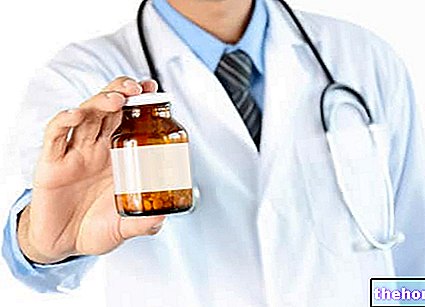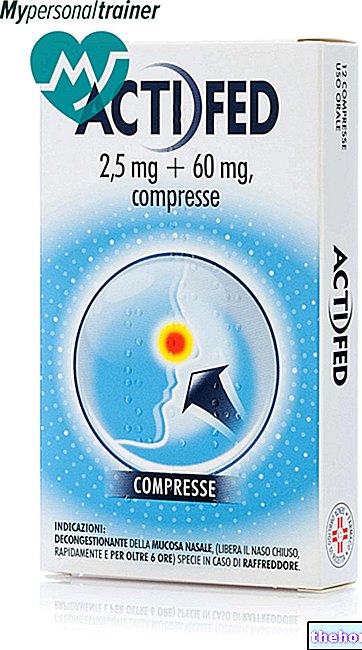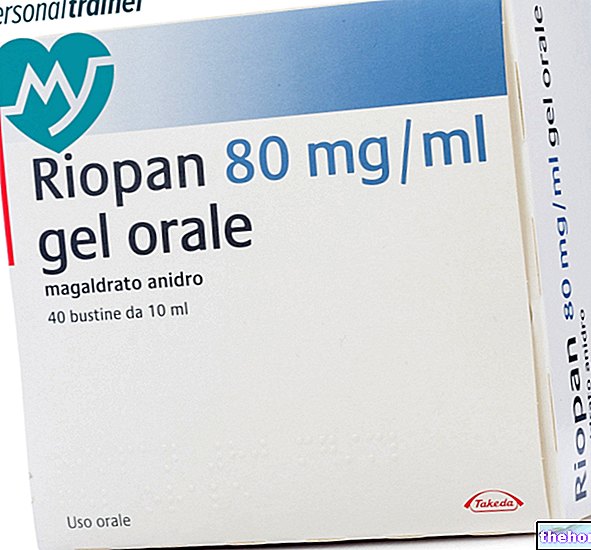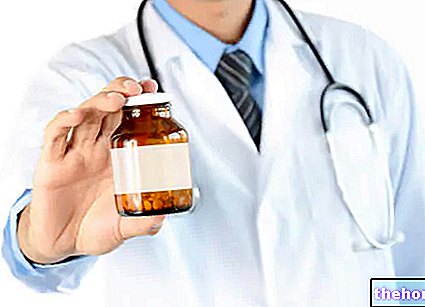Active ingredients: Oxytryptophan (L-5-hydroxytryptophan)
Tript-OH 50 mg hard capsules Tript-OH 100 mg hard capsules Tript-OH 200 mg hard capsules Tript-OH 25 mg granules for oral solution
Indications Why is Tript-oh used? What is it for?
Tript-OH contains the active ingredient L-5-hydroxytryptophan, a substance that mediates chemical reactions in the brain and from which serotonin, a natural substance present in the body, is derived.
Tript-OH is indicated in the treatment of "post-anoxic myoclonus", ie a violent and involuntary contraction of a muscle or group of muscles that occurs after a decrease or absence of oxygen to the brain.
Contraindications When Tript-oh should not be used
Do not take Tript-OH
- if you are allergic to L-5-hydroxytryptophan or any of the other ingredients of this medicine
- if you have severe kidney failure.
Precautions for use What you need to know before taking Tript-oh
Talk to your doctor or pharmacist before taking Tript-OH.
Your doctor may have tests to evaluate your kidney and heart function before prescribing Tript-OH.
As reported for L-tryptophan-based dietary supplements, Tript-OH could also give rise to a disease that causes thickening of the skin (scleroderma syndrome) or an increase in a type of white blood cell (eosinophils) accompanied by pain in the muscles. (eosinophilia-myalgia syndrome).
During your treatment, your doctor may periodically undergo clinical check-ups and blood tests to detect early muscle problems or an increase in a type of white blood cell (eosinophils) in your blood.
Tell your doctor before taking Tript-OH:
- if you have or have had self-harming behaviors or suicidal thoughts because Trip-OH may increase the risk of developing suicidal tendencies, particularly at the start of treatment and in case of dose changes., Your doctor will monitor you closely during the Tript-OH treatment,
Tell your doctor or your caregiver to tell your doctor if you notice during treatment with Tript-OH:
- a worsening of your condition,
- behavior changes
- appearance of suicide-related behaviors or thoughts. During treatment with Tript-OH you will not develop addiction (loss of effectiveness of the medicine over time) or dependence.
Interactions Which drugs or foods can modify the effect of Tript-oh
Tell your doctor or pharmacist if you are using, have recently used or might use any other medicines.
Tell your doctor if you are using one or more of the medicines listed below as they will monitor you during treatment with Tript-OH:
- medicines used in the treatment of depression (monoamine oxidase inhibitors, tricyclic and quadricyclic antidepressants)
- alpha methyldopa (medicine used to treat high blood pressure)
- methysergide (medicine used to treat migraine)
Warnings It is important to know that:
Pregnancy and breastfeeding
If you are pregnant or breast-feeding, think you may be pregnant or are planning to have a baby, ask your doctor or pharmacist for advice before taking this medicine.
If you are pregnant or breastfeeding, the medicine will only be prescribed to you when clearly needed and under the direct supervision of your doctor.
Driving and using machines
There are no known negative effects of Tript-OH on the ability to drive or use machines.
Tript-OH granules for oral solution contains sucrose
If you have been told by your doctor that you have an intolerance to some sugars, contact your doctor before taking this medicinal product. This medicine contains 5 g of sucrose per dose. To be taken into consideration in people with diabetes mellitus. It can be bad for your teeth.
Dose, Method and Time of Administration How to use Tript-oh: Dosage
Always take this medicine exactly as your doctor or pharmacist has told you. If in doubt, consult your doctor or pharmacist.
The recommended dose is 600-1000 mg per day, in 3 separate administrations.
Dissolve the contents of one sachet in half a glass of water.
The duration of therapy may vary from patient to patient and may in some cases last for several months. You should not stop therapy abruptly and without first consulting your doctor.
If you forget to take Tript-OH
Do not take a double dose to make up for a forgotten dose.
If you stop taking Tript-OH
You should not stop treatment abruptly and without first consulting your doctor.
If you have any further questions on the use of this medicine, ask your doctor.
Overdose What to do if you have taken too much Tript-oh
In case of accidental ingestion of an excessive dose of Tript-OH, notify your doctor immediately or go to the nearest hospital.
To date, there have been no reported cases of ingestion of an overdose of Tript-OH.
Side Effects What are the side effects of Tript-oh
Like all medicines, this medicine can cause side effects, although not everybody gets them.
After administration of high doses of Tript-OH the following have occasionally been reported:
- nausea
- mild stomach upset In these cases your doctor may reduce your dose for a few days or prescribe medicines to reduce stomach acid or affect the behavior of the digestive system.
Sometimes the following have been reported:
- Blood pressure changes (returning to normal within 48 hours)
Rarely have been reported:
- Suicidal thoughts and behavior
Reporting of side effects
If you get any side effects, talk to your doctor or pharmacist. This includes any possible side effects not listed in this leaflet. You can also report side effects directly via the national reporting system at www.agenziafarmaco.it/it/responsabili. By reporting side effects you can help provide more information on the safety of this medicine.
Expiry and Retention
Store in the original package to protect the medicine from light.
Keep this medicine out of the sight and reach of children.
Do not use this medicine after the expiry date which is stated on the package after EXP. The expiry date refers to the last day of that month.
Do not throw any medicines via wastewater or household waste. Ask your pharmacist how to throw away medicines you no longer use. This will help protect the environment.
Other information
What Tript-OH contains
Tript-OH hard capsules
- The active ingredient is L-5-hydroxytryptophan. Each capsule contains 50 mg or 100 mg or 200 mg of L-5-hydroxytryptophan.
- The other ingredients are starch, mannitol, magnesium stearate. • The capsule consists of animal gelatin, indigo carmine (50 mg and 200 mg capsules), titanium dioxide, yellow iron oxide (100 mg and 200 mg capsules), erythrosine (100 mg and 200 mg capsules).
Tript-OH 25 mg granules for oral solution
- The active ingredient is L-5-hydroxytryptophan. Each sachet contains 25 mg of L-5-hydroxytryptophan.
- The other ingredients are apricot flavoring, macrogol 4000, sucrose.
Description of what Tript-OH looks like and contents of the pack
Each pack of Tript-OH 50 mg hard capsules contains one blister of 30 hard capsules. Each pack of Tript-OH 100 mg hard capsules contains one blister of 20 hard capsules. Each pack of Tript-OH 200 mg hard capsules contains one blister of 20 hard capsules. Each package of Tript-OH 25 mg granules for oral solution contains 20 sachets of 5 g of granules.
Source Package Leaflet: AIFA (Italian Medicines Agency). Content published in January 2016. The information present may not be up-to-date.
To have access to the most up-to-date version, it is advisable to access the AIFA (Italian Medicines Agency) website. Disclaimer and useful information.
01.0 NAME OF THE MEDICINAL PRODUCT
TRIPT-OH
02.0 QUALITATIVE AND QUANTITATIVE COMPOSITION
TRIPT-OH 50 mg hard capsules
One 50 mg hard capsule contains:
Active principle
L-5-hydroxytryptophan 50 mg
TRIPT-OH 100 mg hard capsules
One hard capsule of 100 mg contains:
Active principle
L-5-hydroxytryptophan 100 mg
TRIPT-OH 200 mg hard capsules
One 200 mg hard capsule contains:
Active principle
L-5-hydroxytryptophan 200 mg
TRIPT-OH 25 mg granules for oral solution
One 25 mg sachet contains:
Active principle
L-5-hydroxytryptophan 25 mg
For excipients see 6.1
03.0 PHARMACEUTICAL FORM
Hard and granulated capsules for oral solution in sachets.
04.0 CLINICAL INFORMATION
04.1 Therapeutic indications
Post-anoxic myoclonus.
04.2 Posology and method of administration
Adults: 600-1000 mg / day. The daily dosage should be divided into three administrations. The contents of the sachet should be dissolved in half a glass of water.
04.3 Contraindications
Severe renal insufficiency, hypersensitivity to the active substance or to any of the excipients.
04.4 Special warnings and appropriate precautions for use
In relation to the possibility that the product, similarly to what has been reported also following the use of dietary supplements based on L-tryptophan, may give rise to a scleroderma syndrome and eosinophilia myalgia syndrome, it is considered appropriate that patients under treatment are subjected to periodic clinical checks and the leukocyte formula in order to be able to detect early the presence of myalgia or a possible hypereosinophilia.
In some cases it is advisable to have a thorough renal and cardiac examination preceding the treatment.
The drug does not present any risk of addiction or dependence.
Suicidal ideation / behavior:
Suicide / Suicidal ideation:
Depression is associated with an increased risk of suicidal thoughts, self harm and suicide (suicide / related events). This risk persists until significant remission occurs. As improvement may not occur during the first or immediate weeks of treatment, patients should be monitored closely until improvement occurs. It is generally clinical experience that the risk of suicide may increase in the early stages of improvement.
Other psychiatric conditions for which TRIPT-OH is prescribed may also be associated with an increased risk of suicidal behavior. Additionally, these conditions can be associated with major depressive disorder. Therefore, the same precautions followed when treating patients with other psychiatric disorders should be observed when treating patients with major depressive disorders.
Patients with a history of suicidal behavior or thoughts, or who exhibit a significant degree of suicidal ideation prior to initiation of treatment, are at increased risk of suicidal thoughts or suicide attempts and should be closely monitored during treatment. of clinical trials conducted with antidepressant drugs in comparison with placebo in the therapy of psychiatric disorders, showed an increased risk of suicidal behavior in the age group below 25 years of patients treated with antidepressants compared to placebo.
Drug therapy with antidepressants should always be associated with close surveillance of patients, particularly those at high risk, especially in the initial stages of treatment and after dose changes. Patients (or caregivers) should be alerted to the need to monitor and report immediately to their physician any worsening clinical picture, the onset of suicidal behavior or thoughts, or changes in behavior.
Keep this medicine out of the reach of children
04.5 Interactions with other medicinal products and other forms of interaction
It is possible to associate L-5-HTP with other specific therapies (for example anxiolytics). Alpha-methyldopa and methysergide block the peripheral decarboxylation of TRIPT-OH; therefore in patients treated with these substances, the drug should be administered with caution.
The association with MAOIs should be carried out with caution. It is necessary to take into account the possible enhancement of tricyclic and quadricyclic antidepressants, of which it may be necessary to reduce the doses.
04.6 Pregnancy and breastfeeding
Teratogenic studies have excluded negative effects on the fetus in animals. Nevertheless, the use of TRIPT-OH during pregnancy and lactation should be limited to cases of absolute necessity, under the direct supervision of the doctor.
04.7 Effects on ability to drive and use machines
TRIPT-OH does not affect the ability to drive and use machines.
04.8 Undesirable effects
In large doses, the drug may occasionally cause nausea and minor gastric disturbances; in this case it is generally sufficient to reduce the dose for a few days and then go back to the useful dose; if necessary, antacid drugs or modifiers of the behavior of the digestive system can be used. Moderate changes in blood pressure can sometimes be observed, returning to normal within 48 hours.
Rare: suicidal ideation / behavior (see section 4.4 Special warnings and special precautions for use).
04.9 Overdose
Since L-5-HTP is a biological substance, no symptoms of overdose are reported in the clinic.
05.0 PHARMACOLOGICAL PROPERTIES
05.1 Pharmacodynamic properties
Pharmacotherapeutic group: The active ingredient of TRIPT-OH is L-5-hydroxytryptophan, a direct physiological precursor of serotonin, which plays the role of an indispensable chemical mediator in the brain.
ATC: N06AX01
Among the various pathogenetic factors of psychic (in particular depression) and neurological diseases, the role played by brain biochemical alterations has been under investigation for some time: much research has been carried out on alterations in the metabolism of biogenic amines, up to the "amine hypothesis "of the pathogenesis of the aforementioned disorders.
There is sufficient evidence to consider important, in the genesis of neuropsychiatric disorders, an "alteration of brain activity" caused by imbalance in the synthesis, storage, release or inactivation of amines and in particular of serotonin: this is in fact decreased in the brain tissue of depressed individuals, as decreased and, in the liquor of these patients, the rate of its metabolite, the "5-hydroxy-indolacetic acid. It was also ascertained a positive correlation between the severity of the depression and the concentration of this metabolite as well as an increase in its phases of clinical recovery after treatment with electroshock or tricyclic and anti-MAO antidepressants Likewise, serotonin deficiency exists in some neurological syndromes. Since exogenous serotonin is unusable, it must be synthesized in the action sites starting from the precursor amino acid: tryptophan. But only 1% of exogenous tryptophan is transformed into serotonin. On the contrary, L-5-hydroxytryptophan easily crosses the blood-brain barrier, avoids the forced passage of tryptophan-hydroxylation and is totally converted into serotonin due to the presence in the brain tissue of a specific enzyme, 5-hydroxytryptophan-decarboxylase.
05.2 Pharmacokinetic properties
L-5-HTP is well absorbed orally; unlike its precursor, it does not bind to whey proteins and is rapidly decarboxylated. The passage of the blood brain barrier is equally rapid. In the albino rat after administration of L-5-HTP there is an increase in cerebral serotonin which reaches its peak at 30 minutes. mcg. In monkeys, the dose of 30 mg / kg increases brain serotonin levels considerably in one "hour, two to six times depending on the regions explored. Elimination occurs via the kidneys in the form of 5-hydroxy-indole acid. -acetic, serotonin catabolite. After a single oral administration of 200 mg / kg in rats, the peak of elimination occurs at the 24th hour.
05.3 Preclinical safety data
Non-clinical data reveal no risk for humans based on conventional studies of safety pharmacology, repeated dose toxicity, genotoxicity, carcinogenic potential, reproductive toxicity.
Studies carried out in rats and mice have shown that the LD50 is negligible if compared to the doses expected in therapy (LD50 per os in mice 2500 mg / kg: LD50 i.p. 1400 mg / kg).
The chronic toxicity studied in the dog at doses of 25 and 50 mg / kg for 16 weeks did not show any alteration of the body weight, of the various organs and systems, as well as of the haematological and blood chemistry parameters. Mild albuminuria appeared in rats at doses of 100 mg / kg.
In cats, endoduodenal administration of 15 mg / kg does not cause alterations in blood pressure, cardiac dynamics, duodenal motility.
L-5-HTP did not show teratogenic activity in rats and rabbits.
06.0 PHARMACEUTICAL INFORMATION
06.1 Excipients
TRIPT-OH 50 mg hard capsules
Excipients:
starch, mannitol, magnesium stearate.
Capsule components: indigo carmine, titanium dioxide, gelatin.
TRIPT-OH 100 mg hard capsules
Excipients:
starch, mannitol, magnesium stearate.
Capsule components: titanium dioxide, gelatin, erythrosine, yellow iron oxide.
TRIPT-OH 200 mg hard capsules
Excipients:
starch, mannitol, magnesium stearate.
Capsule components: titanium dioxide, gelatin, indigo carmine, erythrosine, yellow iron oxide.
TRIPT-OH 25 mg granules for oral solution
Excipients:
apricot flavoring, macrogol 4000, sucrose.
06.2 Incompatibility
L-5-HTP does not present absolute incompatibilities with other specific drugs, but it is necessary to keep in mind, in use, any phenomena of interaction with other psychotropic drugs.
06.3 Period of validity
Stability is 3 years for all packs.
06.4 Special precautions for storage
The product should be stored away from light.
06.5 Nature of the immediate packaging and contents of the package
Box of 30 hard capsules of 50 mg in blister
Box of 20 hard capsules of 100 mg in blister
Box of 20 hard capsules of 200 mg in blister
Box of 20 sachets of 5 g granules
containing 25 mg of active ingredient
06.6 Instructions for use and handling
The contents of the sachet should be dissolved in half a glass of water.
07.0 MARKETING AUTHORIZATION HOLDER
Sigma-Tau Industrie Farmaceutiche Riunite S.p.A.
Viale Shakespeare, 47 - 00144 Rome
Dealership for sale
BIOFUTURA PHARMA S.p.A. - Via Pontina km 30,400 - 00040 Pomezia (RM)
08.0 MARKETING AUTHORIZATION NUMBER
Hard capsules of 50 mg AIC n. 024158014
Hard capsules of 100 mg AIC n. 024158026
Hard capsules of 200 mg AIC n. 024158040
5 g sachets of AIC n. 024158038
09.0 DATE OF FIRST AUTHORIZATION OR RENEWAL OF THE AUTHORIZATION
Authorization
50 mg hard capsules: March 1980
100 mg hard capsules: March 1980
200 mg hard capsules: July 1987
5 g sachets of granules: March 1980
Renewal of the authorization
June 2000
10.0 DATE OF REVISION OF THE TEXT
01/07/2007























-nelle-carni-di-maiale.jpg)




